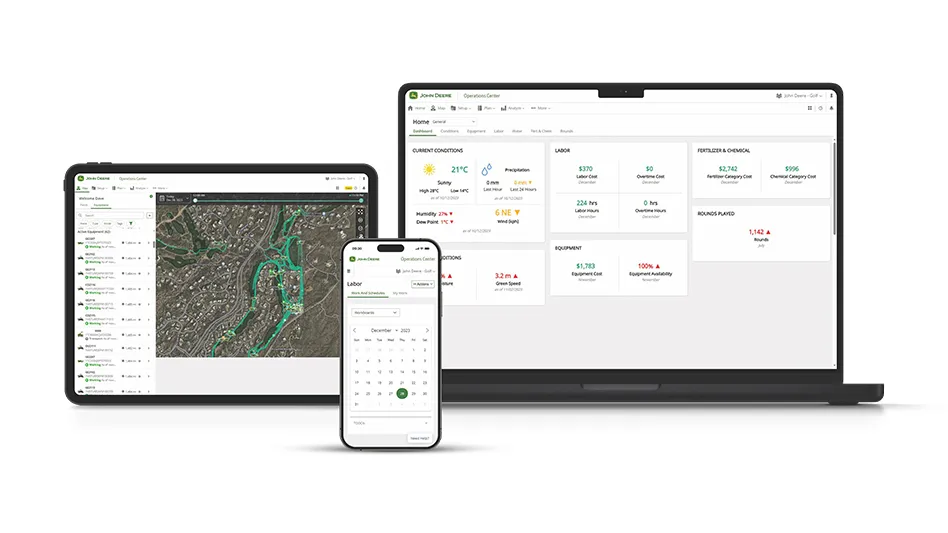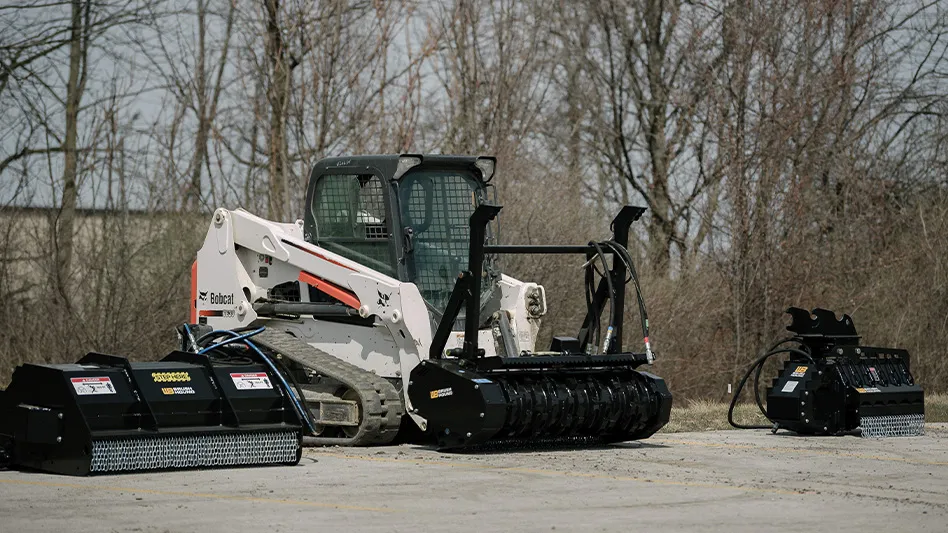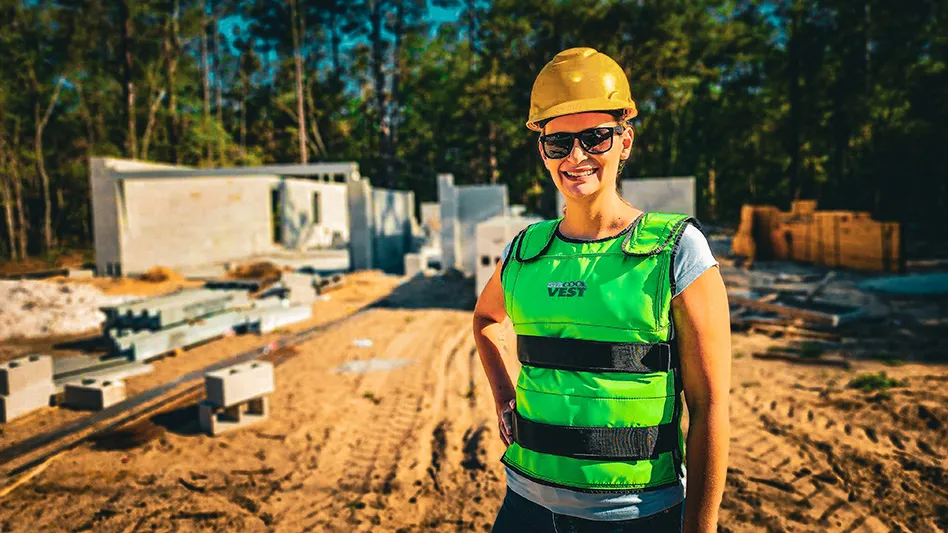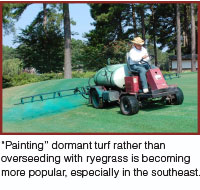 Rembrandt did pretty well for himself in the 17th century — and his legacy extended beyond his brushwork, thanks to a less-celebrated secondary career as a teacher. Rob Vaughan’s best works may never grace the Louvre but like the Old Master, his influence, albeit as an advisor of a different kind, is spreading far. Vaughan, the golf course superintendent at Brunswick Plantation Golf Resort in Calabash, N.C., pioneered the art of fairway painting.
Rembrandt did pretty well for himself in the 17th century — and his legacy extended beyond his brushwork, thanks to a less-celebrated secondary career as a teacher. Rob Vaughan’s best works may never grace the Louvre but like the Old Master, his influence, albeit as an advisor of a different kind, is spreading far. Vaughan, the golf course superintendent at Brunswick Plantation Golf Resort in Calabash, N.C., pioneered the art of fairway painting.
This fall, more courses than ever in the Southeast and elsewhere in the country will use turf colorants instead of ryegrass to give their dormant warm-season fairways the green that golfers love. They are saving tens of thousands of dollars in the process and greatly reducing interference that golfers endure when overseed is sown, grown and mown. Vaughan has helped many superintendents get their toes wet in paint, so to speak, by answering phone calls, emails, giving talks and even turning up on their doorstep to offer advice.
The USGA Green Section’s Southeast region director, Pat O’Brien, projects within five years “maybe only a handful” of courses in resort areas like Myrtle Beach and Hilton Head will overseed. Some facilities that scrapped overseeding to save precious dollars during the recession are now digging deep for money to paint with, excited by the prospect of attracting more play on green fairways in winter.
“I would call Rob Mr. Paint, or maybe Dr. Paint,” O’Brien says of Vaughan’s status as Rembrandt of the fairways. “He was the first. He’s a rock star. He really is. This guy figured it out. The tough part was getting the colorant from the container and onto the fairway and that stuff wasn’t intuitive for people. Not only that, he’s been so generous sharing his knowledge and answering questions from all over the place.”
Vaughan got his start in golf course maintenance in 1975 on the crew under the legendary Fred Meda, then at Raintree Country Club in Charlotte, N.C. When Meda left to join the Myrtle Beach National Company, Vaughan went to North Carolina State University to get a turfgrass degree. After graduating, he rejoined Meda and spent the next 15 years with him. Then he helped Bill Twigg during construction and grow-in of Man-O-War and The Wizard before a few years as superintendent at Buck Creek, now known as Aberdeen Country Club. In 1996, he moved to Brunswick Plantation and has been there ever since.
By his own admission, Vaughan was a little slow to adhere to the idea of painting turf which first took hold on Bermudagrass putting greens. Vaughan converted Brunswick Plantation’s 27 holes to Champion in 2006 and overseeded without a second thought. One November, he sent assistant superintendent Dave Rickenbrode to a winter management seminar at the Carolinas GCSA Conference and Trade Show. There, Rickenbrode heard plenty to like about painting greens as an alternative source of winter color.
“Dave came back and basically said we messed up by overseeding,” Vaughan recalls. “So I went to the same seminar the following year and I came back and told him, ‘Yeah, you were right. We did mess up.’” Vaughan has used a turf colorant on his greens ever since. Ironically, his epiphany came about a decade after he himself had dabbled with the painting idea at the suggestion of his general manager at Buck Creek in 1996. “He wanted to try painting our 328 with a latex paint so we mixed up a batch,” Vaughan says, adding that the experiment was short-lived.
When the bottom fell out of the economy, Vaughan, like every other superintendent in the industry, was charged with reducing costs and getting more out of every dollar that was spent. He looked at what was being forked out on overseeding fairways and saw potential savings if he could successfully extrapolate what he was now doing on his greens.
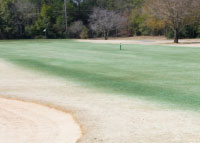 He began mixing up different combinations of colorant and toyed with test plots. But he couldn’t find a solution that didn’t at some point turn the turf blue, which was far from ideal. As O’Brien says, “Golfers don’t like the idea of playing on Boise State’s football field.” Enter Jennifer Seevers, from Geoponics Earth Chemistries.
He began mixing up different combinations of colorant and toyed with test plots. But he couldn’t find a solution that didn’t at some point turn the turf blue, which was far from ideal. As O’Brien says, “Golfers don’t like the idea of playing on Boise State’s football field.” Enter Jennifer Seevers, from Geoponics Earth Chemistries.
“She was standing in my office one day complaining that she couldn’t make a living selling fertilizers in winter,” Vaughan says. “By then I had about 60 different paint samples I’d worked up so I told her to take them and see what she could do. Then - it was October 1, 2010 - she came back out and said she thought she had something. As soon as that thing hit the ground I said, ‘This is it!’”
Vaughan went to his owners and said, “How about giving me nine holes? And they said if we are gonna do nine we might as well do all 27. They’re wonderful people to work for and they trust what I tell them. So then I got a little nervous.”
Generallly speaking, superintendents are rarely encouraged to take risks. The stakes for failed experiments are often considered too high for the facility, let alone the superintendent whose job is on the line. Most superintendents are limited to tinkering around with tests on a nursery green or some out of play area of the golf course, which makes Vaughan’s nerves entirely understandable. It’s not like he could hide 27 holes of fairway if things went wrong.
“That first time, every hole was an experiment,” Vaughan recalls of tweaking nozzle types, pressures, concentrations and more. “But I felt like by the 26th hole we finally got it dialed in.” People noticed. Within no time Vaughan had a visit from Bob Farren, CGCS, and Kevin Robinson, CGCS, from Pinehurst. With the resort engaged in a major push towards sustainability, not to mention men’s and women’s U.S. Opens next year, the combined environmental and financial benefits of painting held a lot of appeal. Of course, there was also the fact that Bermudagrass fairways transition so much better if they don’t have to compete with overseed. “The next day they were buying paint,” Vaughan says.
He recalls one event at Brunswick Plantation where he heard a fellow superintendent telling another that the “overseed looks awesome.” “When he found out it was paint, not ryegrass, he had to go and sit on a fairway and he was immediately on the phone to his GM,” Vaughan laughs. The laughing extends all the way to the bank. Vaughan estimates that he saves about $75,000 a year in labor, fuel, fertilizer, fungicide and so on, by using a turf colorant instead of overseeding.
It is harder to measure any new revenue, although Vaughan is convinced it exists. With the Bermudagrass in better shape earlier –paint can keep soil beneath dormant fairways as much as 10 degrees warmer – and fairways no longer being worked on to establish overseed before the real cold hits, he says his Bermudagrass has gone from being in great golfing shape three months of the year to more nearly 10. Consider, on top of that, O’Brien’s estimate that most daily fee facilities “usually need only five or 10 extra golfers a day to cover the cost of painting.”
They don’t have to be new golfers. Happy customers tend to be repeat customers in any business. O’Brien says turf colorants greatly increase the likelihood of golfer satisfaction. “Fall golf is totally changed for the better,” he says. “Without wet fairways, mud balls and carts on paths, it’s much more enjoyable. And you have better fairways so much sooner in the spring. What are the negatives? Well, really, they are hard to come up with. And Rob is the guy who got us there. He really is some guy.”
Trent Bouts is the editor of Carolinas Green and is a frequent GCI contributor.
Editor's Note: This article originally appeared in the September-October 2013 issue of Carolinas Green. It is reprinted with permission.

Explore the October 2013 Issue
Check out more from this issue and find you next story to read.
Latest from Golf Course Industry
- Devising safer landings
- SiteOne adds Durentis to product offerings
- Resilia available for purchase in Hawaii
- What can $1 million do for expanding the industry workforce?
- Captivating short course debuts on Captiva Island
- Wonderful Women of Golf 35: Carol Turner
- The Andersons acquires Reed & Perrine Sales
- Excel Leadership Program awards six new graduates
